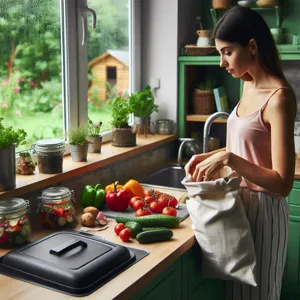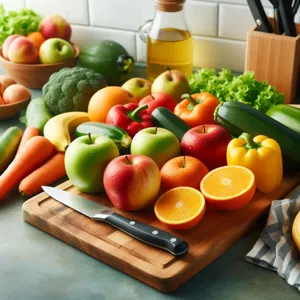In a world where sustainability is more critical than ever, the fight against food waste has become a pressing concern for both the environment and our wallets.
Every year, millions of tons of food are discarded, contributing to unnecessary greenhouse gas emissions and depleting valuable resources. But what if you could turn your kitchen into a bastion of creativity and efficiency, transforming how you think about leftovers and ingredients? In this blog post, we will explore ten innovative strategies to help you slash food waste and make the most of every ingredient. From clever meal planning and storage hacks to inventive recipes that breathe new life into scraps, these tips will not only enhance your culinary experience but also promote a more sustainable lifestyle. Join us as we embark on a journey to cultivate mindful eating habits and discover the joy of minimizing waste in the kitchen!
1. Understanding Food Waste: Facts and Figures

### 1. understanding Food Waste: Facts and Figures
Before diving into strategies for reducing food waste, it’s crucial to understand the scale and impact of the issue. According to the Food and Agriculture Organization (FAO), approximately one-third of all food produced globally—around 1.3 billion tons—is wasted each year. This staggering figure not only highlights the inefficiencies present in our food systems but also underscores the environmental toll of our wasteful habits.
In the United States alone, the Natural Resources Defense Council (NRDC) estimates that food waste accounts for nearly 40% of the total food supply. This equates to about 219 pounds of food per person, per year! The implications are profound; as food decomposes in landfills, it generates methane, a greenhouse gas that is over 25 times more potent than carbon dioxide in terms of its impact on climate change.
The economic ramifications are equally alarming. The USDA reports that food waste costs the average American family approximately $1,500 annually. This figure represents not just the loss of money spent on groceries, but also the resources used in food production, such as water, energy, and labor.
Understanding these facts and figures is the first step toward action. By grasping the magnitude of food waste and its implications, we can motivate ourselves to adopt more mindful practices in our kitchens. Reducing food waste isn’t just a personal benefit; it’s a collective responsibility that can lead to significant environmental and economic improvements. As we explore creative strategies to slash food waste, keep these statistics in mind as a powerful reminder of the difference we can make.
2. Conducting a Kitchen Inventory: Know What You Have
Conducting a kitchen inventory is a vital step toward reducing food waste effectively. It might seem tedious at first, but taking the time to assess your pantry, fridge, and freezer can unveil a wealth of ingredients you may have forgotten about or overlooked. Start by systematically going through each section of your kitchen. Pull everything out, check expiration dates, and make note of what you have on hand. This not only helps you identify items that need to be used up soon but also allows you to rediscover hidden treasures—perhaps that half-used jar of pesto or the bag of quinoa you bought on impulse.
Once you’ve completed your inventory, organize your findings in a way that makes sense for you. Consider keeping a digital or paper list that you can easily reference when planning meals. This practice can help you create a meal plan that incorporates the ingredients you already own, minimizing the temptation to buy more groceries that may end up going to waste.
Additionally, having a clear inventory can simplify your shopping trips. Instead of aimlessly wandering through the grocery store, you’ll be able to stick to your list and only purchase items that complement what you already have. By knowing exactly what’s in your kitchen, you’ll not only save money but also make more informed choices that align with your commitment to reducing food waste. In essence, a well-conducted kitchen inventory is your first line of defense against food waste, empowering you to make the most of your ingredients while fostering a more sustainable kitchen environment.
3. Meal Planning: The Key to Reducing Waste

Meal planning is an essential strategy for anyone looking to slash food waste in their kitchen. By taking a little time each week to plan your meals, you can create a structured approach that maximizes the ingredients you buy while minimizing leftovers and spoilage. Start by assessing what you already have in your pantry and refrigerator—this will not only prevent unnecessary purchases but also inspire creativity in your cooking.
When meal planning, consider designing a balanced menu that incorporates versatile ingredients. For example, if you buy a bunch of kale, plan to use it in multiple dishes throughout the week, such as a hearty soup, a refreshing salad, and a nutrient-packed smoothie. By repurposing ingredients, you not only save money but also ensure that nothing goes to waste.
Another effective tactic is to create a shopping list based on your meal plan. Stick to this list while grocery shopping, avoiding impulse buys that can lead to excess food that might end up in the trash. Many grocery stores even offer apps that allow you to organize your shopping list by aisle, making your trip more efficient and focused.
Additionally, consider batch cooking. Preparing large quantities of meals and portioning them for the week can help you consume food before it spoils. You can freeze portions for later use, ensuring that perfectly good food doesn’t go to waste simply because you couldn’t eat it in time.
Meal planning not only helps reduce food waste but also saves you time and money in the long run. By being intentional about your meals, you cultivate a sustainable kitchen that benefits both your wallet and the planet. Embrace this strategy, and watch as your food waste diminishes while your culinary creativity flourishes!
4. Creative Recipe Ideas for Leftovers
One of the most effective ways to reduce food waste in your kitchen is to breathe new life into leftovers with creative recipe ideas. Instead of letting those uneaten portions languish in the fridge until they’re past their prime, think of them as the building blocks for delicious new meals.
Start by transforming yesterday’s roasted vegetables into a vibrant frittata or omelet. Simply whisk together some eggs, toss in the veggies, and cook until set for a hearty breakfast or brunch option. If you have leftover grains like rice or quinoa, they can be easily repurposed into a refreshing grain salad. Just mix them with fresh herbs, diced vegetables, and a zesty dressing for a nutritious side dish or light lunch.
Another fun idea is to create a “leftover stir-fry.” Gather up whatever veggies, proteins, and grains you have on hand, toss them in a hot skillet with soy sauce or your favorite stir-fry sauce, and you’ve got a quick and satisfying meal that clears out your fridge. For those leftover meats, consider shredding them and mixing with some barbecue sauce for a tasty sandwich filling or topping for homemade pizzas.
Don’t forget about soups and stews! These dishes are a fantastic way to use up odds and ends, as you can throw almost anything into a pot with broth and seasonings. Blend leftover bread into croutons or breadcrumbs to add crunch to salads or as a topping for casseroles. The possibilities are endless, and with a little creativity, your leftovers can take center stage in your next meal rather than ending up in the trash.
By reimagining your leftovers, not only do you save money and reduce waste, but you also have the opportunity to explore new flavors and dishes, making your cooking experience even more enjoyable. So, the next time you find yourself with leftovers, challenge yourself to get inventive and whip up something delicious!
5. Proper Food Storage Techniques to Extend Freshness

Proper food storage techniques are essential for extending the freshness of your ingredients and reducing waste in your kitchen. Many of us toss out perfectly good produce or leftover meals simply because we don’t know how to store them correctly. Understanding the science behind food storage can not only keep your ingredients fresher for longer but also help you make the most of your groceries.
First, consider the temperature settings in your refrigerator. The ideal temperature for most refrigerators is between 32°F and 40°F (0°C to 4°C). Keep your fridge organized to ensure that air circulates freely, allowing for even cooling. Store meat and fish on the bottom shelf to prevent any potential drips from contaminating other foods.
Next, focus on your fruits and vegetables. Some fruits, like apples and bananas, emit ethylene gas, which can accelerate the ripening process of other produce. Keep these ethylene-producing fruits separate from vegetables and other fruits that are sensitive to ripening, such as leafy greens. Use breathable produce bags or containers to maintain moisture levels while allowing for airflow, which can help prevent spoilage.
Additionally, invest in high-quality airtight containers for your leftovers and dry goods. These containers not only prevent moisture and air from spoiling your food but also allow you to see the contents at a glance, reducing the likelihood of forgotten items at the back of your pantry. Label each container with the date it was stored, so you can prioritize using older items first.
Finally, don’t overlook the importance of proper freezing techniques. If you have excess ingredients that you can’t use in time, consider freezing them. Chop vegetables and portion out meals into freezer-safe bags, removing as much air as possible before sealing. This not only helps to retain flavor and nutrients but also allows you to have ready-to-use components on hand, minimizing waste in the future.
By mastering these food storage techniques, you can significantly extend the life of your ingredients and contribute to a more sustainable kitchen. Not only will you save money by reducing waste, but you’ll also develop a more mindful approach to meal preparation and consumption.
6. Utilizing Freezing for Long-Term Food Preservation
Utilizing freezing for long-term food preservation is an efficient and creative way to combat food waste in your kitchen. The freezer is one of the most underutilized tools in many households, yet it holds the key to extending the life of a wide array of ingredients. By harnessing the power of freezing, you can save surplus ingredients that might otherwise spoil, transforming them into convenient meal components for the future.
Start by evaluating your fridge and pantry for items that are nearing their expiration dates or produce that is starting to wilt. Leafy greens, fruits, and vegetables can all be blanched and frozen, preserving their nutrients and flavors for months. Cut up fruits like bananas, berries, or mangoes can easily be frozen in portion-sized bags, making them perfect for smoothies or baking later on. Similarly, leftover soups, stews, and sauces can be stored in airtight containers, allowing you to enjoy a homemade meal on busy days without the hassle of cooking from scratch.
Don’t forget about bulk purchases! If you buy in bulk, portion out your items before freezing them. This not only prevents waste but also makes it easier to grab just the right amount you need for a recipe. Meats, bread, and even cooked grains can be frozen as well, offering flexibility and variety to your meals.
Label each item with the date and contents before you stash them away. This will help you keep track of what you have on hand and ensure that you use items within their optimal timeframe. By making freezing a part of your food preservation strategy, you not only reduce waste but also create a well-stocked, sustainable kitchen ready for whatever culinary adventure awaits. Embrace the freeze, and watch your food waste drop while your meal options expand!
7. Composting: Turning Scraps into Nutrient-Rich Soil

Composting is an incredibly rewarding and transformative practice that allows you to turn kitchen scraps into nutrient-rich soil, all while significantly reducing your food waste. Instead of tossing those vegetable peels, coffee grounds, and eggshells into the trash, consider creating a compost bin where these organic materials can decompose and become valuable compost for your garden.
Starting a compost pile is simpler than you might think. Find a designated spot in your yard or even use a compost bin in your kitchen for smaller spaces. Layer your food scraps with browns—such as dried leaves, cardboard, or shredded paper—to maintain the right balance of carbon and nitrogen. The key is to mix both green materials (like fruit and vegetable scraps) and brown materials to facilitate decomposition.
As the organic materials break down over time, they create a rich, dark soil amendment that can rejuvenate your garden or potted plants. Not only does composting divert waste from landfills, but it also enhances soil structure, improves moisture retention, and increases the soil’s nutrient content. Plus, it’s a wonderful educational opportunity for families to learn about sustainability and the natural cycle of waste.
Imagine the satisfaction of cultivating fresh herbs or vegetables in your garden, knowing that they were nourished by the very scraps you once discarded. Composting is not just a method for reducing food waste; it’s a chance to reconnect with nature, promote biodiversity, and contribute to a healthier planet. So, roll up your sleeves and start composting today—your kitchen, garden, and the environment will thank you!
8. Embracing “Ugly” Produce: Redefining Beauty in Food
In a world increasingly aware of sustainability, embracing “ugly” produce is a powerful strategy to combat food waste while redefining our notions of beauty in food. These oddly shaped fruits and vegetables, often overlooked and discarded, have just as much flavor and nutritional value as their picture-perfect counterparts. By shifting our perspective to appreciate the unique charm of these misfit ingredients, we not only help reduce waste but also support local farmers and markets that strive to sell every part of their harvest.
Imagine a vibrant, rustic salad featuring a lumpy carrot beside a bruised tomato, or a hearty soup made with a collection of quirky potatoes. The truth is that “ugly” produce can add character and creativity to your meals. They may not have the flawless skin that we’ve been conditioned to admire, but they bring a freshness and authenticity that can elevate our cooking.
Incorporating these gems into your kitchen routine can be as simple as visiting local farmers’ markets, where vendors often offer discounted rates for produce that doesn’t meet supermarket standards. Additionally, many grocery stores are now launching initiatives to sell “imperfect” fruits and vegetables at reduced prices, making it easier than ever to embrace this movement.
By choosing to celebrate these unconventional ingredients, you’ll not only help minimize food waste but also inspire your family and friends to do the same. Share your culinary creations on social media, showcasing the beauty of these unique offerings, and challenge the societal norms surrounding food aesthetics. In turn, you’ll be contributing to a larger conversation about sustainability, making a difference one plate at a time. Embrace the charm of “ugly” produce, and watch as your kitchen becomes a canvas for creativity and sustainability!
9. Smart Shopping: How to Avoid Overbuying
Smart shopping is a game changer when it comes to reducing food waste in your kitchen. The key lies in planning and being intentional with your purchases. Before you even step foot in the grocery store, take a moment to assess what you already have on hand. Open your fridge, pantry, and freezer; make it a habit to check for items that may be nearing their expiration date or ingredients that could be turned into a meal. This not only helps you avoid duplicating items but also sparks creativity in your cooking.
Next, create a detailed shopping list based on your meal plan for the week. This list should be strictly adhered to while shopping, keeping impulse buys at bay. Consider using a digital app to organize your list, as many come equipped with features that allow you to categorize items and even track what’s left in your pantry. Stick to the perimeters of the store where fresh produce, dairy, and meats are typically found, and avoid the processed food aisles that tend to lead to unnecessary purchases.
Another savvy tactic is to shop with a friend or family member. Collaborating on grocery runs can help you both share bulk items, cut down on waste, and divide recipes that require similar ingredients, ensuring that nothing goes to waste. If a recipe calls for an ingredient that you know you won’t use up before it spoils, consider whether it can be substituted or if you can find a recipe that utilizes that item in a way that feels fresh and exciting.
Lastly, being mindful of portion sizes is crucial. Overestimating how much you need can lead to excess, so consider cooking in smaller batches or using freezer-safe containers to store leftovers. This way, you can enjoy your meals without the fear of them going bad. By implementing these smart shopping strategies, you’ll not only save money but also play a significant role in minimizing food waste in your kitchen. With each mindful purchase, you’ll be contributing to a more sustainable lifestyle and creating a kitchen that’s kinder to the planet.
10. Engaging Your Family: Making Food Waste Reduction a Team Effort
Engaging your family in the mission to reduce food waste is not just a practical strategy; it’s a powerful way to cultivate awareness and responsibility within your household. When everyone—children included—understands the impact of food waste, they become more invested in the solution. Start by holding a family meeting to discuss the importance of minimizing waste, sharing eye-opening statistics about the environmental and financial burden of wasted food. This dialogue can spark interest and inspire a collective commitment to change.
Next, involve everyone in the kitchen. Allow your children to help plan meals and create shopping lists, emphasizing the need to stick to what you will genuinely use. This hands-on experience not only teaches them valuable life skills but also allows them to appreciate the effort that goes into sourcing, preparing, and consuming food. You can turn meal prep into a fun family activity—let each person choose a dish to make using ingredients you already have on hand. This fosters creativity and encourages everyone to think critically about utilizing what’s available.
Another engaging tactic is to turn food waste reduction into a friendly competition. Set up a family challenge to see who can come up with the most creative way to use leftovers or transform “scraps” into new meals. Maybe it’s a smoothie using overripe fruits or a stir-fry with wilting vegetables. Celebrate the winners with small rewards, like choosing the next family movie for movie night or a special dessert.
Implement a “waste jar” in your kitchen where everyone can place reminders of what food went to waste that week. At the end of the week, review together what could have been done differently. This reflective practice not only raises awareness but also encourages accountability, making everyone more mindful of their food consumption habits.
By fostering a culture of teamwork and creativity around food waste, you not only reduce waste but also instill lifelong habits in your family. Together, you can transform your kitchen into a space that celebrates sustainability and respect for food, making a positive impact on your environment while forging stronger family bonds.
11. Educating Kids About Food Waste: Fun Activities and Lessons
Educating kids about food waste is not only a crucial step in fostering a more sustainable future, but it can also be a fun and engaging experience for the whole family. By incorporating creative activities and interactive lessons, you can help children understand the value of food and the importance of reducing waste in a way that resonates with them.
Start with a family cooking day where everyone participates in meal preparation. Encourage kids to choose recipes that utilize ingredients you might otherwise overlook. For instance, make a vegetable soup where they can select the “ugly” veggies—those oddly shaped or slightly blemished fruits and vegetables that often get left behind at the store. Not only will this teach them to appreciate all food forms, but it will also give them a sense of ownership in the meal.
Another fun activity is a “Waste Watchers” challenge. Set up a contest to see who can create the least amount of food waste over a week. Kids can track their waste and brainstorm ways to repurpose leftovers, like turning stale bread into croutons or using fruit scraps to make smoothies. This not only instills a sense of responsibility but also encourages creativity in the kitchen.
Incorporate lessons about composting into your routine. Create a family compost bin and let the kids take turns adding scraps to it. You can even start a small garden together, showing them how compost enriches the soil and helps grow new food. This hands-on experience will deepen their understanding of the food cycle and highlight the importance of reducing waste.
Lastly, storytelling can be a powerful teaching tool. Share books or documentaries that focus on food waste, sustainability, or the journey of food from farm to table. Follow these sessions with discussions about what they learned and how they can apply that knowledge in their daily lives.
By making education about food waste a fun and interactive experience, you’re not only teaching kids valuable lessons about sustainability but also fostering habits that will carry into their adulthood. This proactive approach can lead to a generation that is more mindful of their food consumption and eager to make a difference.
12. Collaborating with Local Food Banks and Charities
Collaborating with local food banks and charities is not just an altruistic endeavor; it’s a powerful strategy for reducing food waste while simultaneously supporting your community. Many homes and businesses generate surplus food that, if not handled wisely, ends up in landfills, contributing to environmental concerns and wasted resources. By partnering with organizations dedicated to fighting hunger, you can ensure that excess food finds its way to those who need it most.
Start by reaching out to nearby food banks or charities that accept food donations. Establishing a clear understanding of what types of food they accept, along with their donation schedules, can help streamline the process. Many organizations are eager to collaborate, and they may even provide resources or guidance on how best to donate your excess food.
Moreover, consider organizing food drives or community events that not only focus on collecting food but also raise awareness about food waste. Engaging your neighbors and fellow community members can create a ripple effect, inspiring them to rethink their own food consumption habits and encouraging them to contribute to the cause.
Additionally, by highlighting your partnership on social media or your website, you can foster a sense of community involvement and encourage your customers to join the effort. This not only boosts your brand’s reputation but also aligns your business with a greater purpose, making customers feel good about supporting you.
In this way, collaborating with local food banks and charities not only helps to reduce food waste but also strengthens community ties, making your kitchen a hub of positive change. Every meal saved and every bag of groceries donated contributes to a more sustainable future, proving that even the smallest actions can lead to significant impacts in the fight against food waste.
13. Cooking Smaller Portions: Adjusting Recipes for Less Waste
Cooking smaller portions is a simple yet effective strategy to minimize food waste in your kitchen. The idea is to adjust your recipes to create just the right amount of food for your household, ensuring that every ingredient is used and nothing goes to waste. This approach not only saves you money but also encourages you to be more mindful about how much food you actually need.
Start by assessing your typical meals and identifying which recipes consistently yield leftovers. Often, we cook with the assumption that larger portions are better, but this can lead to mountains of uneaten food piling up in the fridge. Instead, consider scaling down your recipes. If a dish traditionally serves four, but you are cooking for just two, simply halve the ingredients.
Moreover, many recipes can easily be adapted for smaller servings with a bit of creativity. When you’re preparing a stir-fry, for instance, use just the quantity of vegetables and protein you plan to eat, adjusting the seasonings accordingly. For baked goods, consider making mini versions or sharing with neighbors or friends, which can be a delightful way to bond while also reducing waste.
Incorporating this strategy also encourages experimentation in the kitchen. You may find joy in trying new combinations of ingredients or using up what you have on hand. It’s a chance to become more resourceful, transforming what might otherwise become waste into delicious, satisfying meals. By cooking smaller portions, you not only help the planet but also cultivate a more intentional and enjoyable cooking experience.
14. Joining Community Initiatives to Reduce Food Waste
Joining community initiatives to reduce food waste can be a transformative step not only for your kitchen but also for your neighborhood. Many communities are now rallying around the shared mission of minimizing food waste, fostering connections among residents while promoting sustainable practices. By participating in these initiatives, you can gain valuable insights and resources to help you manage your kitchen waste more effectively.
One of the most impactful ways to get involved is by participating in local food-sharing programs. These initiatives often involve community members donating surplus food to those in need, ensuring that perfectly edible items don’t end up in landfills. Imagine the satisfaction of knowing that your extra produce is nourishing a family in your area, all while reducing your own waste. Many neighborhoods also host food swaps, where individuals can exchange their excess items for others, fostering a sense of community and creativity in meal preparation.
Moreover, joining a community garden can offer a hands-on approach to understanding food production and waste. Engaging in gardening not only provides fresh, organic produce but also encourages mindful consumption. When you see the effort that goes into growing food, you’re more likely to appreciate its value and reduce waste in your own kitchen.
Additionally, many cities have programs that focus on composting, allowing residents to turn their kitchen scraps into nutrient-rich soil. By participating in these local efforts, you can contribute to a healthier environment while also gaining the knowledge and tools necessary to compost effectively at home.
By immersing yourself in community initiatives, you not only elevate your own practices but also inspire others to be conscious of food waste. Together, you can create a ripple effect that extends beyond your kitchen, fostering a culture of sustainability and responsibility that benefits everyone. So, seek out local groups, attend workshops, and engage with your neighbors to collectively tackle the issue of food waste and build a more sustainable future.
15. Tracking Your Progress: Measuring Your Food Waste Reduction Efforts
Tracking your progress in reducing food waste is not just a practical step; it’s a powerful motivator that can lead to even greater results in your kitchen. By measuring your food waste reduction efforts, you can gain valuable insights into your eating habits, purchasing decisions, and overall kitchen management. Start by keeping a food waste journal where you log what gets tossed out, noting the type of food, quantity, and the reasons for disposal. This practice will help you identify patterns and pinpoint specific areas where waste occurs most frequently.
Consider utilizing apps or online tools designed to track food waste. Many of these platforms allow you to input your grocery purchases and waste metrics, providing visual analytics that can highlight your progress over time. You’ll be surprised at how much more aware you become of your consumption and waste patterns when you see them laid out in front of you.
Additionally, set achievable goals for reducing waste, such as decreasing your kitchen waste by a certain percentage each month. Celebrate small victories along the way to keep motivation high—perhaps treat yourself to a new kitchen gadget or a special meal made from ingredients you would have otherwise discarded.
Regularly review your findings to adjust your strategies accordingly. If you notice that a particular item often ends up in the trash, consider modifying your shopping habits, meal planning, or cooking techniques. By actively tracking your waste and making informed adjustments, you’ll not only contribute to a more sustainable kitchen but also inspire others to join in the effort to slash food waste. This proactive approach transforms food waste reduction from a daunting task into an engaging, rewarding journey.
In conclusion, reducing food waste in your kitchen is not only a crucial step towards a more sustainable lifestyle but also a wonderful opportunity to unleash your creativity and resourcefulness. By implementing the ten creative strategies we’ve shared, you’ll not only save money but also contribute to a healthier planet. From repurposing leftovers into delicious new meals to planning your shopping with precision, each small change can make a significant impact. We encourage you to experiment with these ideas, share your successes, and inspire others to join the movement against food waste. Together, we can cultivate a more mindful approach to our food consumption and ensure that every ingredient is valued and appreciated. Happy cooking, and here’s to a more sustainable kitchen!
——————————












